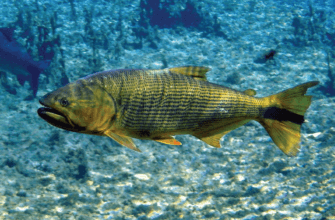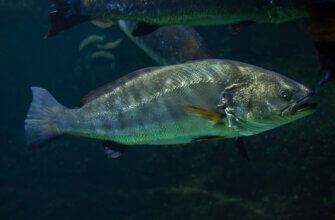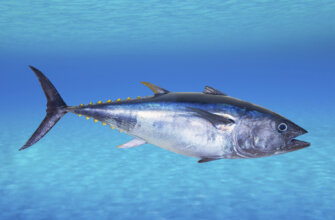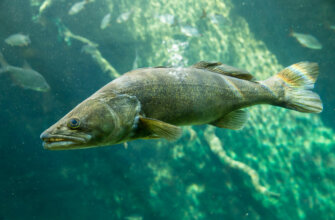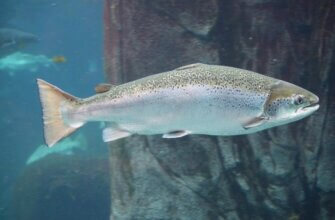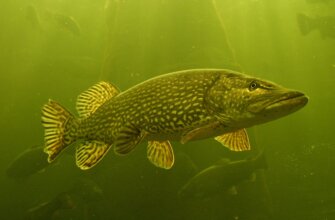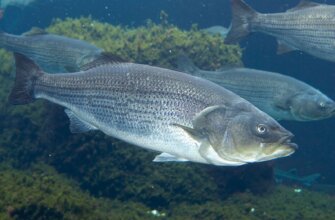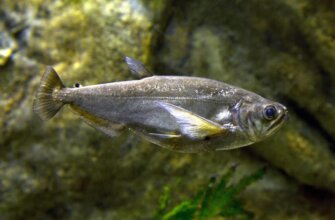The muskie, also known as muskellunge, is a species of freshwater fish native to North America. It is a member of the pike family, closely related to the northern pike and pickerel. The muskie is known for its large size, predatory nature, and its popularity among anglers as a challenging game fish.
The muskie is highly regarded among anglers for its challenging nature and reputation as a prized game fish. It is known for its large size, powerful strikes, and aggressive predatory behavior.
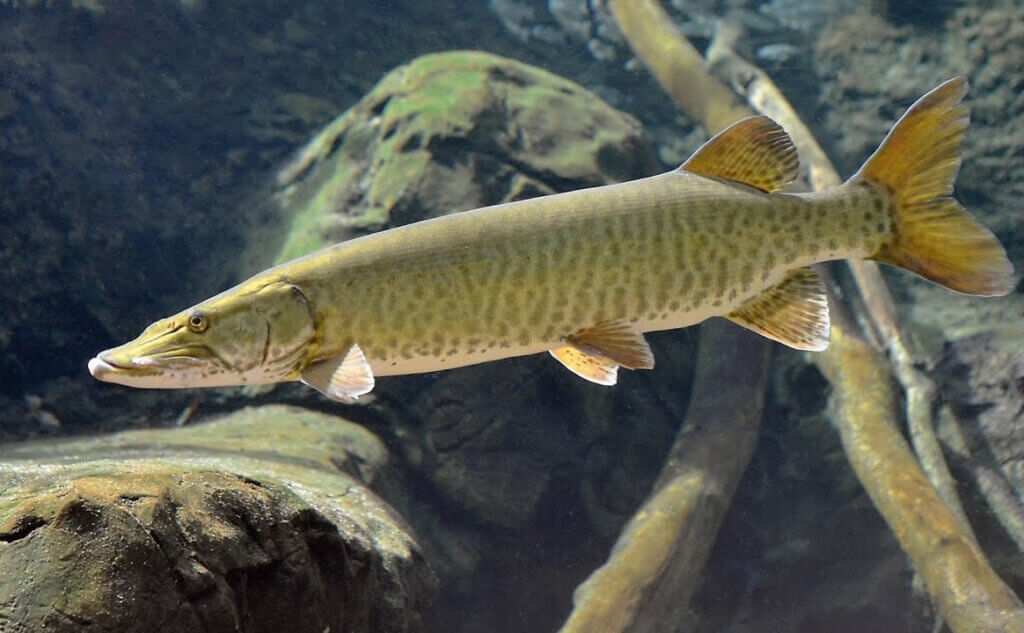
The muskie has a distinctive appearance with a long, torpedo-shaped body covered in dark markings or bars along its sides. It has a broad, flat head with a large mouth filled with sharp teeth, which it uses to capture and consume its prey. Its coloration varies, ranging from light brown to dark green or gray, blending in with its surroundings to aid in ambushing its prey.
Muskie are primarily found in freshwater habitats, including lakes, rivers, and reservoirs across North America. They require clear, well-oxygenated water and prefer areas with ample vegetation or cover, such as submerged logs, weed beds, and rocky structures. These areas provide suitable ambush points for muskie to lie in wait and strike at their prey.
In terms of diet, muskie are apex predators and have a diverse appetite. They feed on a variety of prey, including fish such as perch, bass, and smaller muskie, as well as frogs, crayfish, and even small mammals or waterfowl if the opportunity arises.
Due to their popularity as a challenging sport fish, muskie have been stocked in various locations outside their native range, including some parts of Europe. They are often pursued using specialized techniques, such as casting large lures or using live bait, and many anglers consider catching a muskie to be a significant accomplishment.
It’s worth noting that while the muskie can be an exciting fish to catch, it’s important to practice responsible angling and adhere to local fishing regulations to ensure the conservation and sustainability of muskie populations.
Appearance
The muskie (Esox masquinongy) is a large predatory fish with a distinct appearance.
Here are some details about the muskie’s appearance:
- Body Shape. Muskies have a long, torpedo-shaped body with a cylindrical shape. They have a broad and flat head, which tapers to a pointed snout. The body is muscular, designed for powerful bursts of speed.
- Coloration. The coloration of muskies can vary depending on their habitat and age. Generally, they have a mottled or spotted pattern on a background color that can range from olive green to brown. The sides of the body have irregular vertical bars or spots that are darker in color. The belly is lighter in color, often white or cream.
- Fins. Muskies have a dorsal fin located far back on their body, almost near the tail. The dorsal fin is followed by a series of smaller fins, including an anal fin, pelvic fins, and pectoral fins. The tail fin, or caudal fin, is deeply forked and provides powerful propulsion.
- Teeth. One of the muskie’s distinctive features is its mouth full of sharp teeth. They have long, canine-like teeth in their jaws, which they use to capture and hold onto their prey.
Overall, the muskie’s appearance is impressive and built for speed and power, making it an exciting and challenging fish to catch for anglers.
Size and weight
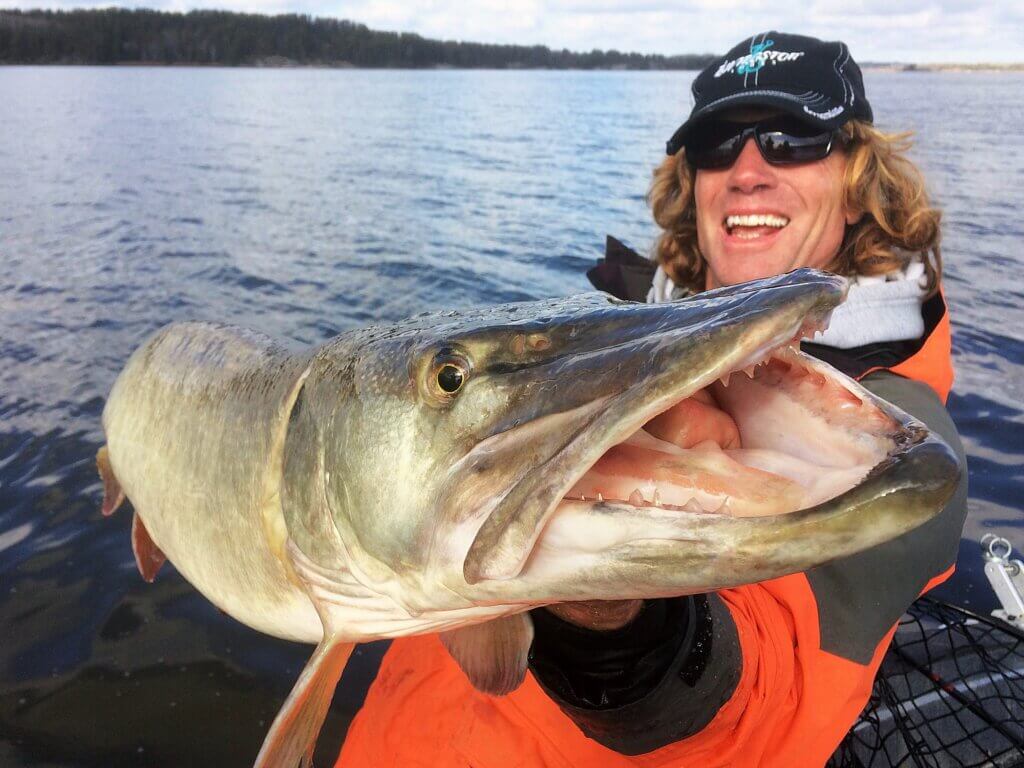
Muskies (Esox masquinongy) are known for their large size and can reach impressive lengths and weights.
Here’s some information about the size and weight of muskies:
- Length: Adult muskies typically range from 30 to 60 inches (76 to 152 cm) in length. They have been known to grow even larger, with exceptional individuals exceeding 60 inches (152 cm). The length of a muskie is measured from the tip of the snout to the tip of the tail.
- Weight: The weight of muskies can vary depending on factors such as age, habitat, and food availability. Adult muskies commonly weigh between 10 and 30 pounds (4.5 to 13.6 kg). However, some individuals can grow much larger. A muskie weighing over 50 pounds (23 kg) is considered a remarkable catch.
It’s important to note that muskies are a popular target for anglers seeking trophy-sized fish. Catching a muskie of significant size is often considered a great accomplishment due to their elusive nature and challenging behavior.
Diet
Muskies (Esox masquinongy) are apex predators and have a voracious appetite. Their diet primarily consists of other fish, but they are known to be opportunistic and will consume a variety of prey.
Here are some details about the diet of muskies:
- Fish. Muskies are piscivorous, meaning they primarily feed on other fish. Their diet includes a wide range of fish species, such as perch, walleye, bass, trout, and smaller members of their own kind. They are well-equipped for capturing and devouring fish with their sharp teeth and powerful jaws.
- Amphibians and Reptiles. In addition to fish, muskies may also consume amphibians and reptiles. This can include frogs, snakes, and even small turtles if given the opportunity.
- Birds and Small Mammals. Although less common, muskies have been known to prey on birds and small mammals that come close to the water’s surface. This usually occurs when the opportunity presents itself, such as a bird landing on the water or a small mammal swimming near the shoreline.
- Invertebrates. While not a major part of their diet, muskies may occasionally consume invertebrates such as crayfish, insects, and crustaceans.
It’s worth noting that the diet of muskies can vary depending on the availability of prey in their specific habitat. They are known to be opportunistic feeders, and their diet can adapt based on the local food sources.
Behavior
Muskies (Esox masquinongy) exhibit several interesting behaviors that make them unique and sought after by anglers.
Here are some key behavioral characteristics of muskies:
- Aggressiveness. Muskies are known for their aggressive behavior. They are apex predators and possess a voracious appetite. When hunting for prey, they display bursts of speed and ambush their targets, often striking with lightning-fast attacks. This aggressive nature adds to their reputation as a challenging and exciting fish to catch.
- Solitary Nature. Muskies are solitary fish and are typically found alone rather than in large groups or schools. They are known to patrol specific areas of their habitat, often staking out ambush points near structure or cover where they can lie in wait for prey. Their solitary nature can make them challenging to locate and target.
- Territoriality. Muskies are territorial and defend their home ranges against intruders. They establish and protect their preferred areas, which can be several acres in size, especially during the spawning season. Muskie territory is often characterized by specific structures, such as weed beds, submerged logs, or rocky points.
- Ambush Predation. Muskies are ambush predators that rely on their stealth and explosive bursts of speed to capture prey. They often lie in wait near structures or drop-offs, using their excellent camouflage to blend in with their surroundings. When prey comes within striking distance, muskies exhibit remarkable acceleration and strike with a sudden lunge, engulfing their prey in their large mouths.
- Seasonal Movement. Muskies exhibit seasonal movements within their habitat. They may migrate to different areas of the water body in search of suitable spawning grounds or to follow the movement of their prey. Understanding these seasonal patterns can be crucial for anglers looking to target muskies effectively.
- Elusive and Challenging. Muskies are known for their elusive nature, which adds to the allure of pursuing them. They can be challenging to catch due to their wariness, selective feeding habits, and ability to escape hooks or lures. Muskie fishing often requires patience, skill, and specialized techniques.
These behavioral traits contribute to the reputation of muskies as “the fish of 10,000 casts” and make them a highly sought-after species among anglers seeking a thrilling and rewarding fishing experience.
Spawning
Muskies engage in an annual spawning process, during which they reproduce. The timing and specific behaviors associated with muskie spawning can vary depending on geographical location and environmental conditions.
Here is some general information about muskie spawning:
- Timing. Muskie spawning usually occurs in the springtime when water temperatures reach the appropriate range. This typically happens between late April and early June, depending on the region. The exact timing can vary depending on factors such as latitude and water conditions.
- Spawning Habitat. Muskies prefer shallow, weedy areas for spawning. They typically seek out areas with dense vegetation, such as emergent aquatic plants or submerged vegetation, where they can lay their eggs and find protection for the young. Suitable spawning habitat often includes marshes, bays, backwaters, and shallow areas near shorelines or islands.
- Courtship and Nest Building: Male muskies initiate the spawning process by selecting a spawning site and building a nest known as a “redd.” The male clears away debris and vegetation from the selected area, creating a circular depression in the substrate using its tail and body movements. The nest-building process can take several days to complete.
- Spawning Act. Once the nest is ready, the male muskie seeks out a receptive female. During the spawning act, the male swims alongside the female and fertilizes the eggs as she deposits them into the nest. The pair may engage in a twisting, rolling motion during the act.
- Egg Development and Incubation. After the female deposits her eggs, the male guards the nest to protect it from potential threats. The eggs, which are adhesive and stick to the substrate, undergo a period of incubation. The duration of the incubation period can vary but typically ranges from 9 to 14 days, depending on water temperature.
- Fry and Juvenile Development. Once the eggs hatch, the resulting fry stay close to the nest and rely on their yolk sacs for nourishment initially. As the fry grow, they start feeding on small aquatic invertebrates and eventually transition to a diet of small fish. The male muskie continues to guard the fry until they disperse and become more independent.
It’s important to note that muskie spawning behavior can be influenced by local conditions and variations in populations. Additionally, fishing regulations often protect spawning muskies to ensure the sustainability of their populations.
Fishing
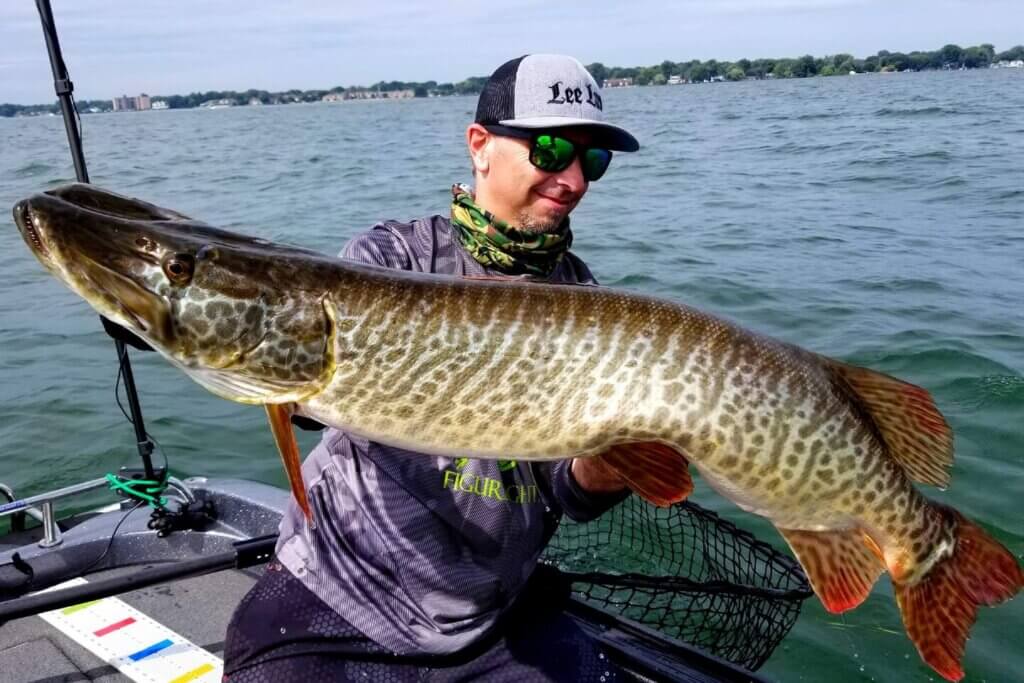
Fishing for muskies (Esox masquinongy) is a popular and exciting pursuit for many anglers.
Here are some tips and considerations for fishing muskies:
- Equipment. Muskie fishing requires sturdy and specialized equipment. A heavy or medium-heavy action casting rod, preferably 7 to 9 feet in length, paired with a high-capacity baitcasting reel, is commonly used. Use a strong, abrasion-resistant fishing line with a test rating between 50 to 80 pounds. Muskie lures are typically larger and heavier, including jerkbaits, bucktails, crankbaits, and topwater lures.
- Location and Habitat. Muskies are often found in lakes, reservoirs, and rivers with suitable habitat. Look for areas with submerged vegetation, weed beds, rocky structures, drop-offs, and points, as these can be prime muskie-holding spots. Pay attention to depth changes and areas where baitfish are present.
- Time of Day. Muskies can be caught throughout the day, but early morning, late evening, and low-light conditions are generally considered prime times. They tend to be more active during these periods, especially during the warmer months.
- Presentation and Techniques. Muskie fishing involves using a variety of techniques to entice strikes. Some common techniques include:
- Casting and Retrieving: Cast your lure near structure, cover, or potential muskie ambush points. Retrieve the lure with pauses, jerks, or irregular movements to imitate wounded prey. Vary the speed and depth of your retrieve to find what triggers the muskies.
- Figure Eight Technique: After retrieving your lure near the boat or shore, perform a figure-eight motion with the lure at the end of the retrieve. This technique mimics a baitfish changing direction, which can trigger a muskie to strike.
- Trolling: Trolling involves dragging lures behind a slowly moving boat. This technique covers a large area and allows you to explore different depths and structures. Use deep-diving crankbaits, inline spinners, or large bucktail spinners for trolling.
- Patience and Persistence. Muskie fishing can be challenging, and it often requires perseverance. Muskie are known as the “fish of 10,000 casts” because they can be elusive and selective in their feeding habits. Stay focused, keep casting, and maintain confidence in your presentation.
- Practice Catch and Release. Muskie populations are often managed through catch and release practices. Handle muskies with care, use appropriate tools such as large landing nets and hook removers, and release them quickly to ensure their survival and conservation.
Remember to check local fishing regulations and obtain any necessary licenses or permits before fishing for muskies. It can also be beneficial to seek guidance from experienced muskie anglers or hire a local guide who can provide valuable insights and increase your chances of success.
Lures
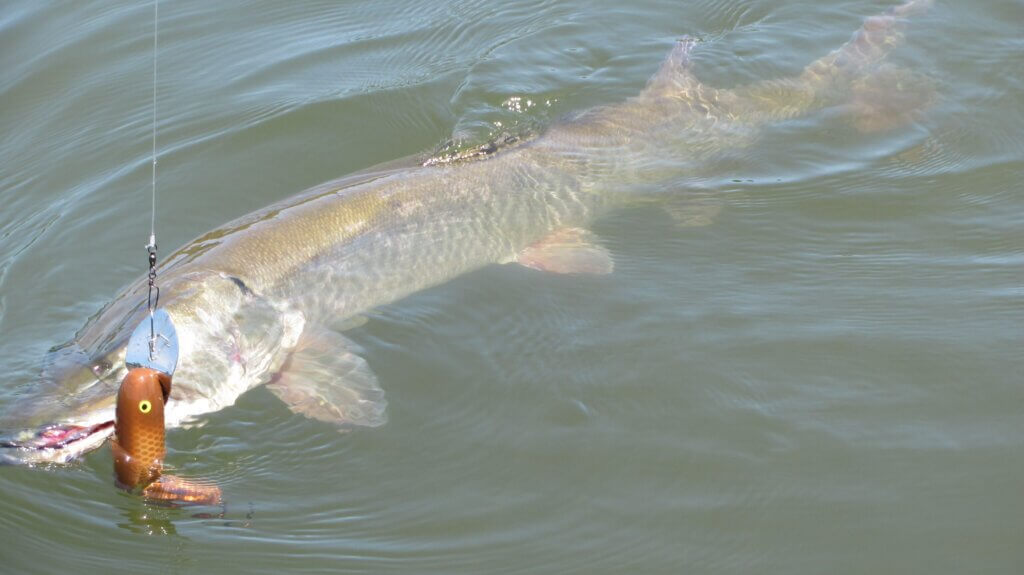
When targeting muskies (Esox masquinongy), using the right lures can greatly increase your chances of success. Muskie lures are typically larger and designed to mimic the prey fish that muskies feed on.
Here are some popular types of lures used for muskie fishing:
- Bucktails: Bucktail lures consist of a lead head adorned with hair or feathers that resemble the tail of a buck (male deer). These lures create lifelike movement in the water, and their flashy appearance can attract muskies. Bucktails can be retrieved at varying speeds, and their versatility makes them effective in a wide range of fishing conditions.
- Jerkbaits: Jerkbaits are long, slender lures with a hard plastic or wooden body. They are designed to imitate wounded baitfish. Jerkbaits are typically used with a twitch-and-pause retrieve, giving them an erratic action that entices muskies to strike. These lures are effective for targeting muskies in both shallow and deep water.
- Crankbaits: Crankbaits are hard-bodied lures with a diving lip. They are known for their ability to dive to specific depths, allowing you to target muskies at different water levels. Crankbaits often have a realistic fish-like appearance and create a wobbling or vibrating action as they are retrieved. Use crankbaits with a steady retrieve or with occasional pauses and twitches to trigger strikes.
- Topwater Lures: Topwater lures are designed to create commotion and draw muskies to the water’s surface. They include surface plugs, prop baits, and walk-the-dog lures. Topwater fishing for muskies can be exhilarating, as you witness explosive strikes when a muskie attacks the lure from below.
- Soft Plastic Baits: Soft plastic baits, such as swimbaits and rubber worms, can be effective when targeting muskies. They offer a more lifelike feel and action, and some come with built-in scent attractants. Rig them on a weighted hook or with a specialized muskie jighead for best results.
- Spinnerbaits: Spinnerbaits combine a spinner blade or blades with a lead head and a skirt of hair or silicone strands. The spinning blades create vibration and flash in the water, attracting muskies from a distance. Spinnerbaits are versatile lures that can be retrieved at various speeds and depths.
It’s essential to experiment with different lure styles, colors, and sizes to find what works best in your fishing location and conditions. Pay attention to the preferences and recommendations of local anglers or fishing guides, as they can provide valuable insights specific to the muskie population in your area.
When it comes to fishing for Muskie, there are several types of lures that are popular and effective. Here are some examples of fishing lures for Muskie, along with their models and specifications:
- Bucktail Spinnerbaits:
- Model: Mepps Musky Killer.
- Specifications: Features a large bucktail skirt, a weighted body, and a spinner blade. Available in various colors and sizes to imitate different baitfish.
- Jerkbaits:
- Model: Suick Thriller.
- Specifications: A large, hard-bodied lure with a realistic finish. It has a diving lip and a side-to-side darting action when jerked. Available in different colors and sizes.
- Topwater Lures:
- Model: Jackall Pompadour.
- Specifications: A surface bait with a unique propeller design that creates a buzzing and splashing action. It has a feathered treble hook and is available in various colors.
- Soft Plastic Swimbaits:
- Model: Bull Dawg.
- Specifications: A large soft plastic bait with a paddle tail and a realistic body shape. It can be rigged with a weighted hook or used on a jig head. Comes in different colors and sizes.
- Spinnerbaits:
- Model: Mepps Giant Killer.
- Specifications: A heavy-duty spinnerbait with a large blade, sturdy wire frame, and a silicone skirt. It produces flash and vibration to attract Muskie. Available in different colors.
- Glide Baits:
- Model: Spro BBZ-1.
- Specifications: A jointed, hard-bodied lure that mimics the swimming action of a baitfish. It has a lifelike finish and slow-sinking or floating options. Comes in various colors and sizes.
- Bucktail Jigs:
- Model: Musky Innovations Bulldawg Bucktail.
- Specifications: A bucktail jig with a bucktail skirt, a lead head, and a sturdy hook. It can be fished vertically or horizontally and comes in different colors and weights.
Remember, Muskie fishing can vary depending on the region and specific conditions, so it’s always a good idea to consult with local anglers or bait shops for recommendations tailored to your fishing location.
Baits
When it comes to bait for Muskie, live bait and artificial lures are commonly used.
Here are some examples of baits that are effective for Muskie fishing:
- Live Baits:
- Large Suckers: Live suckers, particularly those around 8 to 12 inches in length, are a popular choice for Muskie fishing. They can be fished under a bobber or with a bottom rig.
- Ciscos: Ciscos, also known as lake herring, are oily baitfish that Muskie find irresistible. They can be hooked through the lips or on the back near the dorsal fin.
- Artificial Lures:
- Large Spinnerbaits: Big, flashy spinnerbaits with oversized blades and a bulky profile can provoke aggressive strikes from Muskie. Choose spinnerbaits specifically designed for Muskie fishing.
- Jointed Swimbaits: Jointed swimbaits mimic the movement of injured baitfish, making them attractive to Muskie. Opt for larger sizes with a realistic finish.
- Soft Plastic Baits: Soft plastic baits like paddle tail swimbaits and curly tail grubs can be effective for Muskie. Rig them on a heavy-duty jig head or with a weighted hook.
- Crankbaits: Large, deep-diving crankbaits with a wide wobbling action are productive for targeting Muskie. Look for models designed to withstand the powerful strikes of Muskie.
It’s important to note that Muskie fishing regulations and bait preferences may vary depending on the specific body of water and region. Always check the local fishing regulations and consult with experienced anglers or local bait shops to determine the most effective baits for Muskie in your area.
Rods
When it comes to Muskie fishing, it’s essential to have a sturdy and specialized rod that can handle the size and strength of these powerful fish.
Here are some examples of Muskie fishing rods:
- St. Croix Legend Tournament Musky:
- Model: LTMU86XHF.
- Specifications: Length – 8’6″, Power – Extra Heavy, Action – Fast, Line Weight – 30-65 lbs, Lure Weight – 3-10 oz.
- Features: High-modulus SCIV graphite construction, Fuji K-Series tangle-free guides, Fuji PTS blank-touch reel seat, and premium cork handle.
- Shimano Compre Muskie:
- Model: CMCM80H.
- Specifications: Length – 8’0″, Power – Heavy, Action – Fast, Line Weight – 50-80 lbs, Lure Weight – 3-8 oz.
- Features: IM-9 graphite construction, Fuji Alconite guides, Fuji reel seat, and durable EVA handle.
- G. Loomis E6X Musky:
- Model: E6X 904C MBR.
- Specifications: Length – 7’6″, Power – Heavy, Action – Moderate-Fast, Line Weight – 30-50 lbs, Lure Weight – 1-4 oz.
- Features: High-modulus graphite construction, Fuji Alconite guides, Fuji reel seat, and premium cork handle.
- Okuma EVX Musky Rod:
- Model: EVX-C-861XH-Tb.
- Specifications: Length – 8’6″, Power – Extra Heavy, Action – Fast, Line Weight – 50-80 lbs, Lure Weight – 3-10 oz.
- Features: 30-ton carbon composite construction, Fuji Alconite guides, Fuji reel seat, and comfortable EVA handle.
- Daiwa Lexa Muskie:
- Model: LEXA-LC86XHF.
- Specifications: Length – 8’6″, Power – Extra Heavy, Action – Fast, Line Weight – 40-80 lbs, Lure Weight – 2-8 oz.
- Features: IM-7 graphite construction, Fuji aluminum oxide guides, Daiwa custom reel seat, and durable EVA handle.
These are just a few examples of Muskie fishing rods available on the market. It’s important to consider the specific fishing techniques, lure weights, and line weights you’ll be using, as well as your personal preferences for rod length and power when choosing a Muskie rod. Additionally, consulting with experienced Muskie anglers or visiting local bait and tackle shops can provide valuable insights and recommendations tailored to your fishing location.
Dishes
Muskie is a type of fish, specifically the Muskellunge, known for its firm, white flesh and mild flavor. It is commonly prepared and enjoyed in various culinary styles.
Here are a few dishes that feature muskie:
- Grilled Muskie. Marinated with herbs and spices, the muskie fillets are grilled to perfection, resulting in a smoky and flavorful dish.
- Muskie Chowder. A creamy soup made with muskie chunks, potatoes, onions, celery, and other vegetables, seasoned with herbs and spices.
- Muskie Tacos. Muskie fillets are breaded and fried until golden, then served in warm tortillas with fresh salsa, avocado, and a squeeze of lime.
- Muskie Piccata. Pan-fried muskie fillets are topped with a tangy sauce made with lemon juice, capers, butter, and white wine, creating a delicious and zesty dish.
- Muskie Cakes. Similar to crab cakes, these patties are made with muskie meat, breadcrumbs, herbs, and seasonings, then fried until crispy and served with a dipping sauce.
- Muskie Po’ Boy. A classic sandwich where battered and fried muskie fillets are placed in a soft roll, topped with lettuce, tomatoes, pickles, and a zesty remoulade sauce.
- Muskie Stew. A hearty stew made with muskie chunks, vegetables, broth, and seasonings, slow-cooked until the flavors meld together.
- Muskie en Papillote. Muskie fillets are cooked in parchment paper along with herbs, vegetables, and a drizzle of olive oil, creating a moist and flavorful dish.
- Muskie with Lemon Butter Sauce. Pan-seared muskie fillets are served with a rich and velvety lemon butter sauce, which adds a burst of citrus flavor to the dish.
- Muskie Sushi. Thinly sliced muskie fillets can be used in sushi rolls or served as sashimi, providing a delicate and fresh seafood option.
These are just a few examples of how muskie can be prepared and enjoyed. Feel free to experiment with different flavors and cooking techniques to create your own unique muskie dishes.

